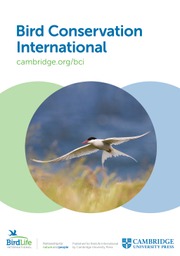Article contents
Exploring potential reasons for the increase in the East Asian Greylag Goose Anser anser population by assessing habitat use and use of protected areas
Published online by Cambridge University Press: 19 August 2022
Summary
Among the six sympatric swan and goose species wintering in the Yangtze River floodplain, only Greylag Goose Anser anser and Bean Goose A. fabalis showed increasing population trends in the last 20 years. Until now, almost nothing was known about the Greylag Geese breeding on the eastern Mongolian Plateau, which we now know mostly winter in the Yangtze River floodplain. We applied GPS transmitters to 20 Greylag Geese in the Yangtze River floodplain and eastern Mongolia, providing complete tracks of their movements in summer, winter, spring and autumn (n = 6, 8, 8, 7). We overlaid these locations on GIS layers of habitat type and national-level protected areas, and modelled their habitat selection. Geese summered in Dauria Region, Huihe National Nature Reserve, and Wulagai Wetlands (from where 55% of GPS fixes were located in protected areas), wintered in Poyang Lake, Longgan Lake, and Anqing Lakes (43%), and staged around Bohai Bay, Xila Mulun River, and Wulagai Wetlands (spring, 48%; autumn, 45%). Geese mainly used natural ecosystems in summer (essentially grasslands and wetlands/water bodies), but in the other three seasons, used croplands between 17% (spring) and 46% (winter) of the time, with most of the rest of the time spent on wetlands/water bodies. Geese were frequently associated with wetlands and areas close to lakes/wetlands in all seasons, and cropland during winter and spring/autumn migration. These results suggest Greylag Geese in this biogeographical sub-population have increasingly shifted to feeding in croplands during the non-breeding season and enjoy the benefit of using protected areas throughout the year. We infer that these factors could have potentially contributed to elevated survival and reproductive success (relatively high among sampled flocks in recent years) which could explain the favourable conservation status of this population of Greylag Geese in recent years compared to other sympatric wintering goose and swan species.
Information
- Type
- Research Article
- Information
- Copyright
- © The Author(s), 2022. Published by Cambridge University Press on behalf of BirdLife International
References
- 7
- Cited by

